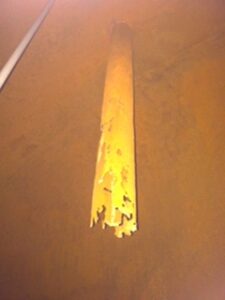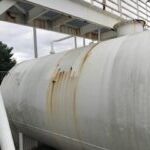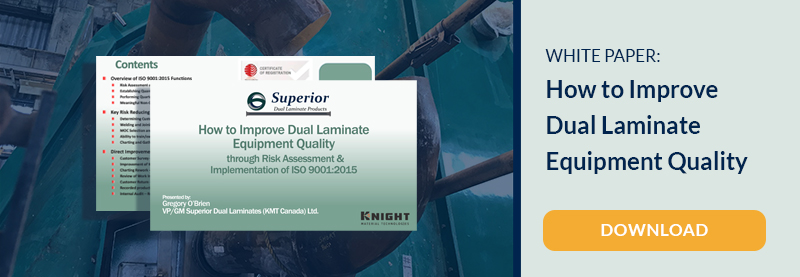Fluoropolymer Field Lining Installation: Why it is a Viable Option to Consider
Published on: October 17, 2023 Topics: LiningsPicture yourself as the Plant Manager in one of the many industries that rely on specialty alloys, glass linings or other corrosion-resistant materials to protect your equipment and keep your production running on schedule. You’ve just gone into shut down for annual maintenance. Your inspection team informs you that your critical process vessel is shot and needs to be replaced. Not what you wanted to hear, obviously.
 Corroded Dip Pipe and Pitted Alloy
Corroded Dip Pipe and Pitted AlloyNow, you have a few choices to consider, including:
- Put a Band-Aid on the problem and run the risk of safety, environmental and production issues down the road.
- Remove the tank from the production line, decon it and ship it to an off-site facility for what will likely be weeks, maybe months, of downtime while a new internal coating is installed.
- Purchase a new vessel and deal with long lead times, materials availability and fabrication issues.
- Find one of the very few companies in the world capable of doing a field installation of a high-temperature, extremely corrosion resistant fluoropolymer lining on-site at your plant.
Of course, you’d pick the fourth option. If the installation can be done on-site, you save a lot of money and eliminate weeks, if not months, of production outage.
But, why are so few companies capable of installing a fluoropolymer lining in the field? Why are so few companies able to offer a service that is an excellent option to consider? Because it takes special equipment, highly skilled welding technicians, comprehensive safety training and an ability to work in just about ANY physical environment, not just the controlled environment of a vendor’s shop.
Few are willing – or capable – of investing and delivering on these requirements.
Hurdle number one. If you’re going to work in someone else’s facility or outdoors, you no longer control the physical environment. Temperature and humidity variables are now in play. And that presents unique lining installation challenges.
Welding fluoropolymer sheets is a highly technical task, even when done in the controlled environment of one’s home shop. Now imagine what happens when this work needs to be done in 80% humidity, at 38°F or in near-desert conditions. The weather affects the adhesive bonding and the flow of the weld material. Knowing how to compensate for these variables and lay down a secure, reliable weld bead is a job only for an extraordinarily accomplished fluoropolymer welder.
 Exterior of Degraded Chemical Storage Tank
Exterior of Degraded Chemical Storage TankNext, if you’re going to install fluoropolymer sheet lining outside of your own shop, that means you have to make your equipment portable, including your power and compressed air supply. Most vendors don’t want to invest in the additional inventory to make mobility possible.
Plus, working outside of your own plant requires differently-rated worker’s comp insurance. i.e. it costs more. Sometimes a lot more. After all, it’s much riskier to work out in the weather or at someone else’s facility. Most companies don’t want to worry about that additional insurance cost. So it is the rare company that’s undergone the additional safety training and put in place the additional safety protocols that protect their people and keep their worker’s comp affordable.
Something often overlooked when thinking about field installation is that it requires an expanded set of project management skills. Whether managing lodging, meals, shift transportation or the logistics of materials and equipment, your on-site contractor must be properly prepared. They must be able to create a safe, efficient environment, including staging, storage and work areas. Most companies do not have adequately trained personnel to effectively implement on-site installations.
Keep in mind that all the above insights apply to dual laminate equipment, not just lined steel equipment. Often a company will purchase dual laminate FRP piping from a vendor, have those pieces shipped to them, and hire local, less experienced labor to assemble the pipes. If you follow this practice, be sure your installers have welding experience in the desired thermoplastic lining, which may include fluoropolymers, PVC, CPVC or PP.
 Fluoropolymer Lining Specialists
Fluoropolymer Lining SpecialistsWelding fluoropolymer materials is very different than joining other thermoplastics such as PVC or polypropylene. Throw in those temperature and humidity variables that come with field installation, and it could be a lot more difficult to achieve a secure joint.
One last skill to consider. Efficiency. You’ve invested in this work to be done on-site because you want to be back in production as soon as possible. You may even be trying to get the work done during an annual shutdown. That means you need an experienced team who knows how to make it all happen effectively and efficiently.
When it comes time to hire someone to field install a fluoropolymer lining at your facility, use the above criteria while you screen candidates. This should help you ensure they can do the job the way you need it done.



